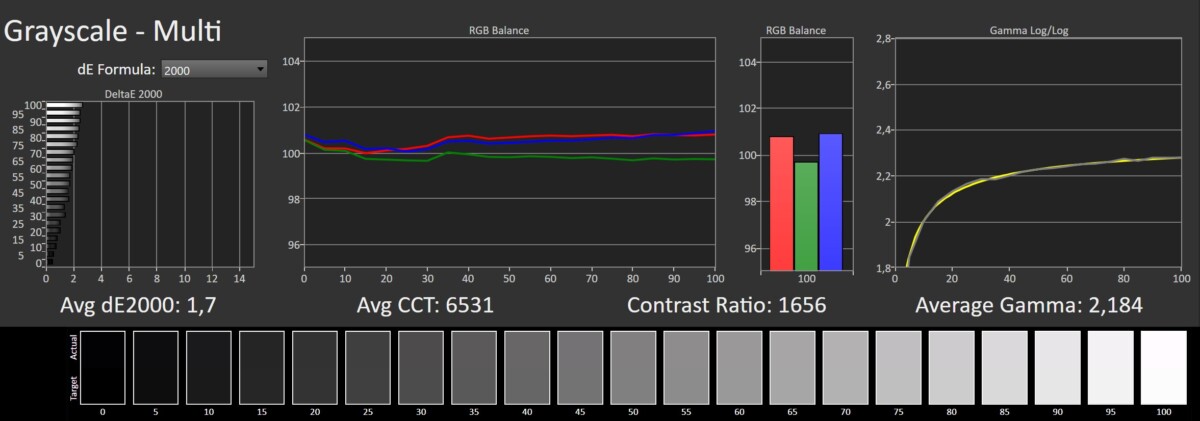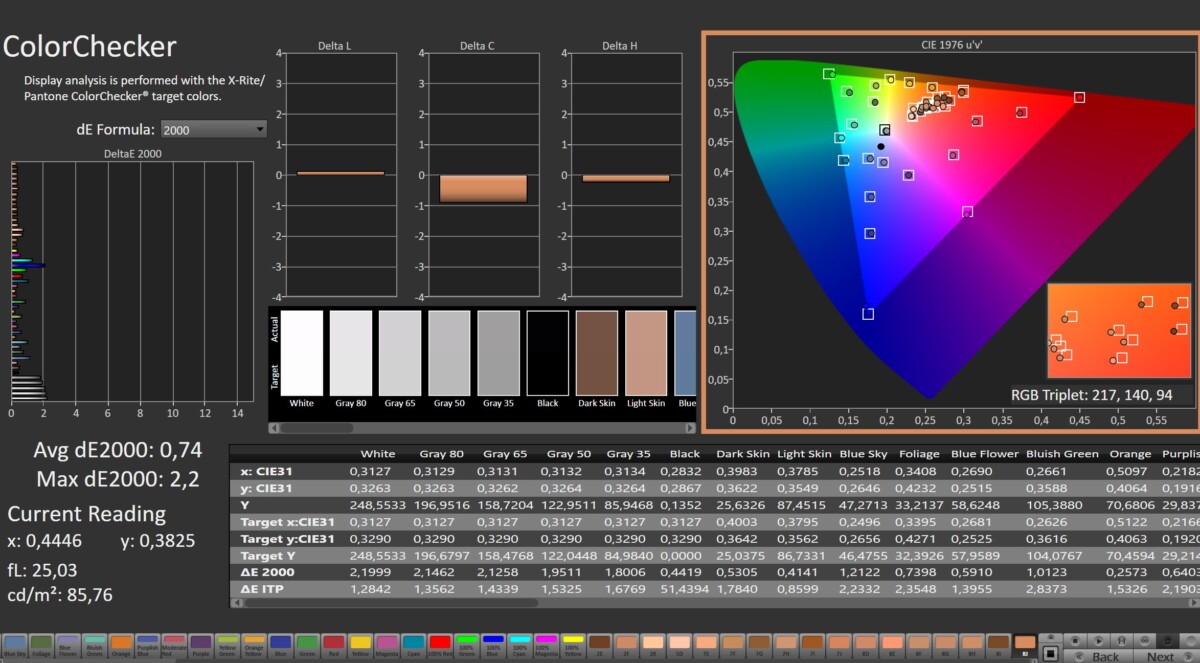In the field of office screens, Dell is clearly one of the most represented manufacturers. Its very wide range can sometimes be too dense for its own good, but offers quality models for many professional uses.
The UltraSharp range in particular is a good compromise between purely office use with technical services for creatives. We have one of them to test, the Dell UltraSharp 27 U2724D, a 27-inch screen that pulls the LCD upwards with a rather attractive proposition for less than 400 euros.
Dell UltraSharp 27 U2724D data sheet
| Model | Dell UltraSharp 27 U2724D |
|---|---|
| Dimensions | 621.24 cm x 192.28 cm |
| Screen size | 27 inches |
| Form factor | 16:9 |
| Definition | 2560 x 1440 pixels |
| Display frequency | 120Hz |
| Response time | 5ms |
| Maximum brightness | 350 cd/m² |
| Number of HDMI ports | 1 |
| Number of DisplayPort ports | 2 |
| Built-in speakers | No |
| USB | Yes |
| Weight | 6.56kg |
Product sheet |
The screen was loaned by Dell for this test.
A minimalist and ergonomic screen
Dell screens are recognizable by their sobriety and this U2724D is no exception to the rule. With its matte panel with thin edges, it will fit into any desk. On the front, the only presence of the logo stands out on the silver gray support, which we will talk about again.
Source: Chloé Pertuis for Frandroid

Aesthetic considerations are put in the background here, the screen focuses on a smooth appearance at the back with a joystick button for adjustments and another for tensioning on the right side, in our opinion much more practical than the numerous buttons from the manufacturer’s old models (even the S range now offers it).
Connections
The Dell UltraSharp U2724D offers complete connectivity with an HDMI 2.1 port, two DisplayPort ports (including an input for chaining a second monitor), an upstream USB-C port and no less than two USB-A ports as well as a USB port -C outgoing supporting the USB 3.2 Gen 2 standard at 10 Gbit/s. The latter supports charging up to 15W for your different devices.

Source: Chloé Pertuis for Frandroid

Source: Chloé Pertuis for Frandroid
It is possible to configure this screen with an even more extensive connectivity offering by choosing the U2724DE model, which offers a USB-C Thunderbolt 4 port that can both serve as a video connection with the DisplayPort alternative mode, but also for charging up to 90W. An RJ45 port is also present on this more expensive model.
Support
The support remains in the great Dell tradition with a simple foot which has the advantage of not taking up too much space, much less than the Oled models that we were able to test. The advantage compared to certain other office models of the brand is its numerous ergonomic adjustments. In addition to a classic tilt forwards and backwards, you can also adjust the screen in height, but also use it vertically, in portrait mode.

Source: Chloé Pertuis for Frandroid

Source: Chloé Pertuis for Frandroid
Image quality
Our different measurements are accessible at the end of this part of the test.
The Dell UltraSharp U2724D screen offers a 27-inch IPS Black panel in 1440p definition with a refresh rate of 120 Hz. The IPS Black panel stands out from the classic IPS with greater contrast and greater colorimetric precision for different creative works.
We tested the panel from every angle with our Calibrite ColorChecker Display Plus probe with Calman Ultimate software. Firstly, it was a question of verifying the promises of the panel in terms of contrast, which can theoretically rise to a value of 2000:1, much higher than what classic IPS panels offer (around 1000:1).
By default, it is 1682:1, providing deeper blacks than our other Dell desktop monitor in comparison (the Dell S2721D). To reach the maximum value, we set the brightness and contrast to the maximum in the screen menu, and we arrived at a ratio of 1966:1, very close to the technical sheet therefore.

The brightness of the screen is faithful to that communicated by Dell, with 246 cd/m² on factory settings and a peak at 349 cd/m² once the brightness and contrast settings are pushed to their maximum. This is the standard for this type of screen, so no worries at this level.
In terms of colors, the promises are almost kept with coverage of 135% of the sRGB space and 91% of DCI-P3 and 90% of Adobe RGB, so enough to suit amateur creatives working in these different spaces. But does the screen display these colors correctly? Here, we’ll compare performance on Standard mode, the default setting, and in the most accurate mode we could measure.
The default color temperature is measured at 6430, an excellent value very close to the D65 white point recommended for normal ambient light conditions. If we switch the screen to its sRGB mode, this value increases to 6506, almost perfect, even if the difference will not necessarily be felt by everyone.

It is with its colorimetric accuracy that this screen impressed us. If the default Standard mode brings us to a Delta-E of 4.54, with deviations on blue tones, a relatively correct value, but far from precise for the most demanding. By switching the screen to sRGB mode, this value increases to 0.74, a simply excellent value which confirms the hybrid positioning between productivity and creation of the screen.

The performance of this IPS Black panel comes at the slight expense of reduced viewing angles compared to a conventional panel. We were able to experience this by comparing it to an S2721D office panel, and the difference was felt. . But this shouldn’t be a problem if you have the screen correctly positioned in front of your eyes.
The uniformity of the panel remains correct even if we noticed some light leaks at the edges of the image, but much less pronounced than some gaming screens with insufficient quality control. Some chromatic drifts are felt on the different edges of the screen, but nothing too pronounced to be annoying on a daily basis.

Finally, the contribution of a refresh rate of 120 Hz is undeniable for visual comfort, whether for scrolling web pages or moving windows. The trend is increasingly being observed in office and creative ranges, which is good news.
However, don’t imagine yourself playing competitive games on this screen, even if it can be used for casual solo gaming with its very good contrast and latency of 4.2 ms at 120 Hz. Gray to gray response times of 10 ms only reserves this type of game, but we will not judge this screen on this point.
| Contrast | 1685:1 (default) 1966:1 (max) |
| Brightness | 246 cd/m² (default) 349 cd/m² (max) |
| Range of colors | 135% sRGB 91% DCI-P3 90% Adobe RGB |
| Delta-E | 4.54 (default) 0.74 (sRGB) |
Consumption
The power consumption of the Dell UltraSharp U2724D seemed to us to be well managed by the manufacturer. We measured the screen according to the standard W/m² index (number of watts per square meter). On a 10% test pattern displayed via Calman Ultimate, at a brightness of 150 cd/m², we reached 78 W/m² at 120 Hz, and slightly less at 60 Hz (around 73 W/m²).
This is a very good value, significantly lower than certain gaming screens and in particular Oled which can exceed 100 W/m².
Price and availability
The Dell UltraSharp U2724D has fallen back below the 400 euro mark at the time of writing this test. You will find it at 388 euros on the manufacturer’s official website and around 370 at third-party retailers.
Where to buy
Dell UltraSharp 27 U2724D at the best price?
In our opinion, this is a good price for the services it offers and in particular its versatility between office automation and creative work. The U2724DE model and its superior connectivity offer is 100 euros more expensive.
